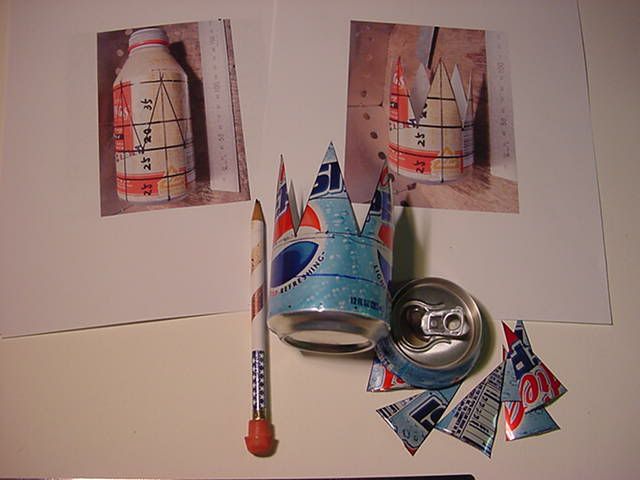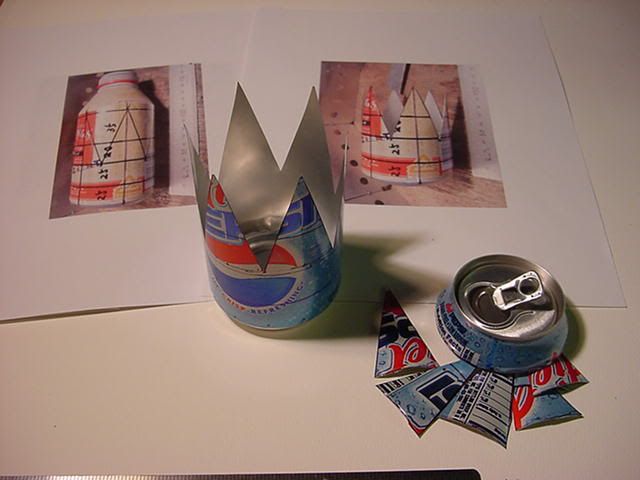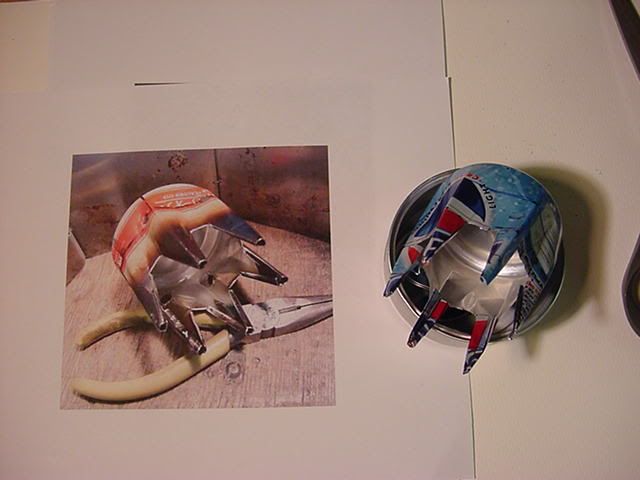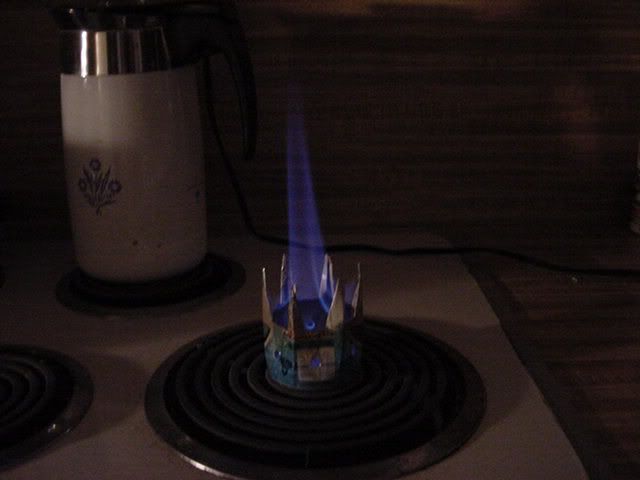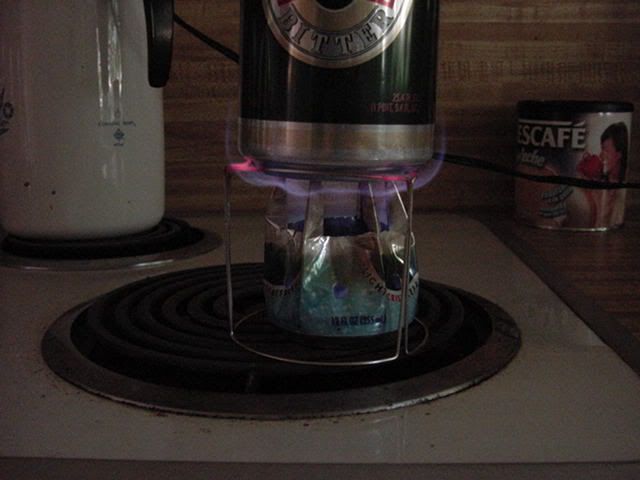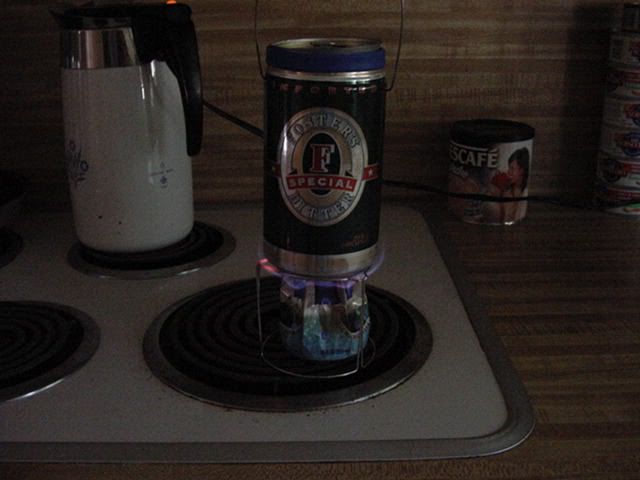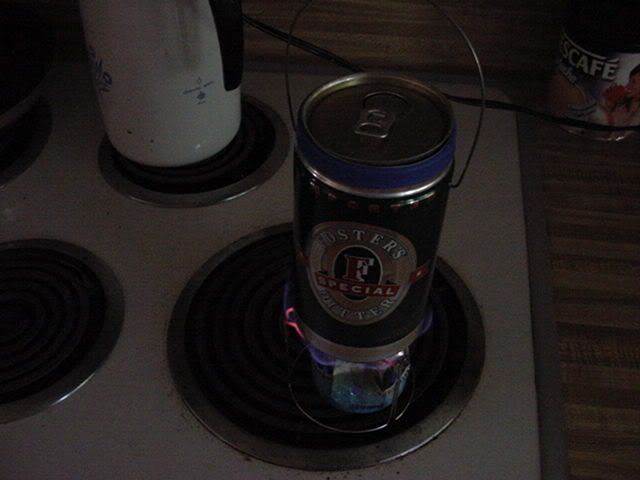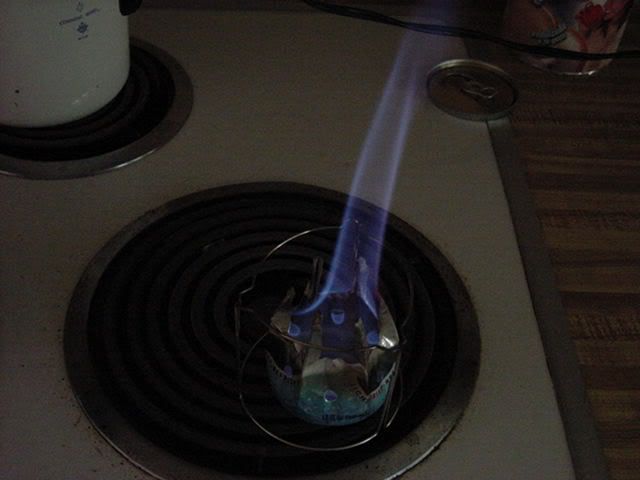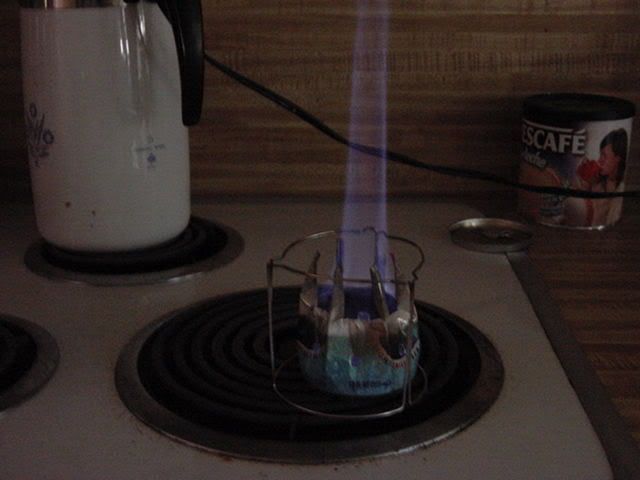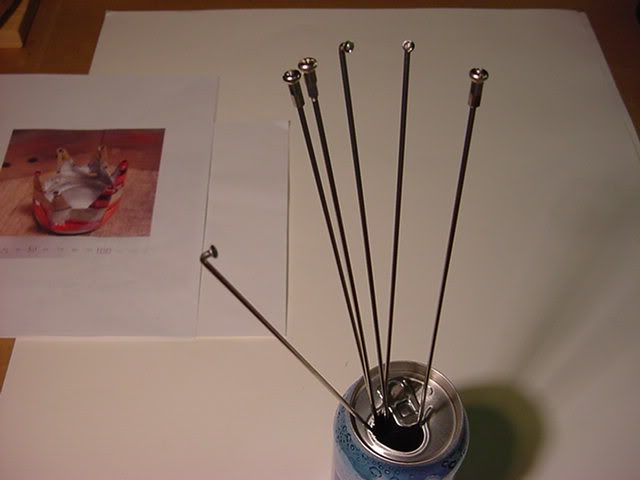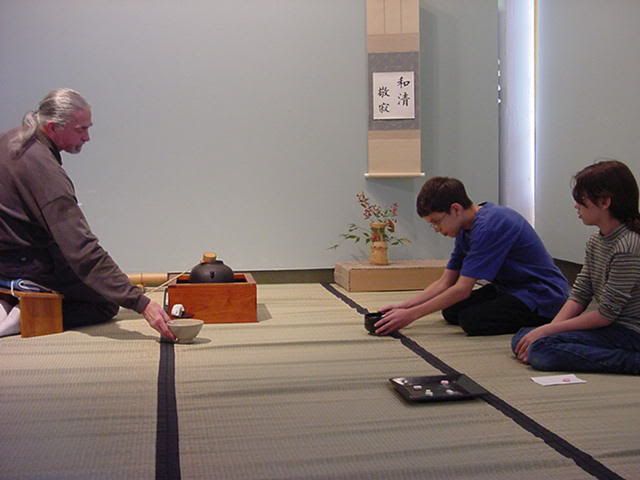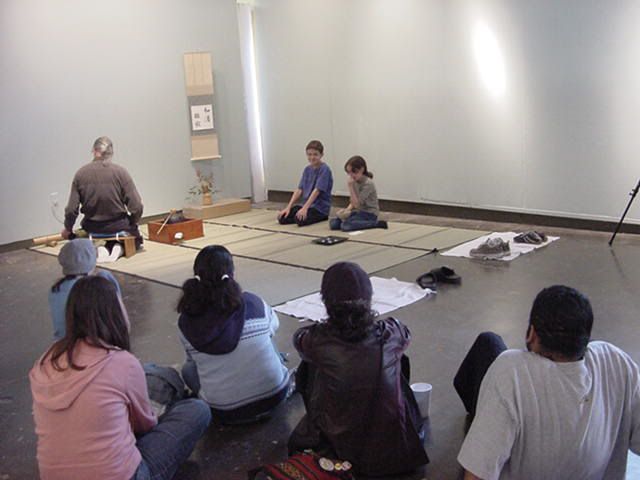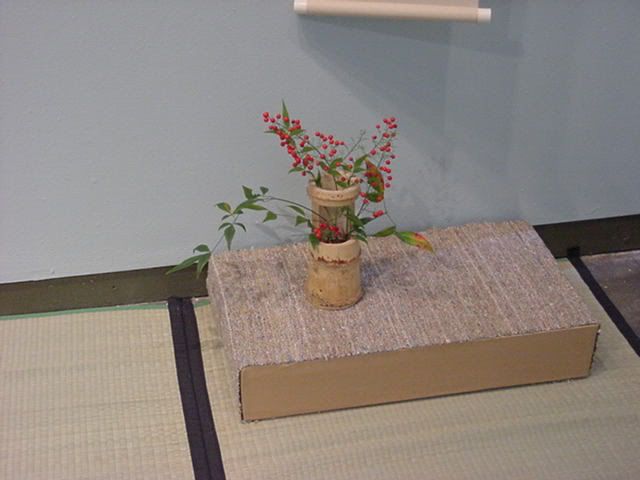Topic
Japanese influenced (JSB) alcohol stove
Forum Posting
A Membership is required to post in the forums. Login or become a member to post in the member forums!
Home › Forums › Gear Forums › Make Your Own Gear › Japanese influenced (JSB) alcohol stove
- This topic is empty.
-
AuthorPosts
-
Aug 26, 2005 at 12:33 am #1216684
I have enjoyed looking at Yukio Yamakawa (JSB’s) small alcohol stoves so much that I had to make one. This is my first but I know it will not be my last. It weighs 0.25oz and seems to burn good. I will try an boil some water with it tomorrow.




 Aug 26, 2005 at 7:07 am #1340904
Aug 26, 2005 at 7:07 am #1340904It seems like that may (or one made out of a smaller can) may sit right in the depression in the bottom of a henie can-pot…
Aug 26, 2005 at 10:07 am #1340915Joshua, The Fosters & Henie…. can bottom depressions seem to be the same and the top of this stove sets inside that depression. However, the stove legs are not strong enough to support the can with water in it.
I just did my first “boil test” and used the bottom part of my Ultralight Outfitters stove to support the Fosters Cook Pot. You can see this in the pictures.
I started my test with tap water and what I call a “cold start”.
I put the Fosters can with water on the stove and then started the stove. I used the Fosters can lid for my Pot Lid.
Between 3 and 4 minutes I had bubbles in the water.
Between 5 and 6 minutes I had a “Rolling Boil”.
The last two pictures just show the stove burning after the water was removed.






 Aug 26, 2005 at 11:08 am #1340916
Aug 26, 2005 at 11:08 am #1340916Is the benefit that they relay some of the heat back down into the alcohol to help it vaporize?
I wonder if one built a wire or stainless mesh stand that sat inside the spikes if it would hold the weight of the pot or if ir would be to unstable.
Also, I wonder if one made from one of the heavier duty aluminum bottles would hold… though that’s probably more wishful thinking on my part.
Aug 26, 2005 at 6:31 pm #1340949Joshua: Your question “So, why the “spikes”??
I am into Heavy Metal music?
No, I Just tried to copy the pictures. I haven’t figured out the Japanese comments with the pictures yet.
I also thought about using wire to reinforce the spikes. I went to visit my supply stores this afternoon. I couldn’t find Stainless Steel wire.
I am going to make another stove like this one and not cut as much of the can away. I will fold the side and then fold the spike in half. This will leave more of the can and maybe make it stronger. I also may try some thin strips of my Titanium for reinforcement.The only aluminum cans I have to cut up are soda cans. Today I bought a sports drink. It is made in the shape of a glass bottle but aluminum. It seems to be heavier aluminum than the soda cans. I will make the next version with 5 spikes and see if I can fold them to be stronger. The spikes held the Fosters can for a short time with water in it before one of the spikes bent. I think the design is good I just need to make a few of them and see what the best way to fold the can turns out to be.
I believe that the aluminum cans Yukio Yamakawa is using is heavier than my soda cans.
Aug 26, 2005 at 7:45 pm #1340951It would be nice if the spikes on the JSB stoves would be able to support a pot. That is one of things that I liked about the stoves (assuming the spikes are pot supports). One of the things I don’t like about most of the soda can stoves is the need for a separate pot support. Not a big deal to have a separate support but it’s nice when it’s integrated into the stove. It’s one of the things I like about the little brasslite stoves.
Stainless steel wire: If there is a bicycle shop in your area, you can get bicycle spokes. The ones you want are DT swiss or Wheelsmith, these are the most common and will be made of stainless. They generally run under a dollar a piece. The better ones are butted, meaning that the center section is thinner than the ends. 2.0/1.8 gage and 1.8/1.6 are the most common. The lightest (about 4 grams apiece) are DT revolutions, 2.0/1.5 gage. These are very thin in the middle. They will probably run about a buck a piece.
Aug 26, 2005 at 8:49 pm #1340953Daniel, I think the idea of the spikes is that they would support a cook pot. I think if I fold them in a different way they might be strong enough to support a Fosters or Heineken cook pots. This would give you a one piece stove/pot stand in one very light unit. As a stove my first one worked good.
Don’t you know my nickname is Titanium Bill. I have 6 Titanium spokes that I bought for a project a long time ago and then used something else. My Ti spokes are 0.27oz each.
 Aug 26, 2005 at 9:43 pm #1340955
Aug 26, 2005 at 9:43 pm #1340955Hello Bill and everyone.
I’m posting this from Japan.
Maybe you know the JSB’s stove can make cyclone flame. The secret of the cyclone is based on the direction of air hole. See the hole position and it’s angle carefully please. JSB’s air hole is located near the ridge line of the pot stand. The location is not middle of the pot stands. The direction of air hole doesn’t face to the center of the can.From Japan with love!
Aug 26, 2005 at 10:24 pm #1340957Hideaki-san, Thank you for your reply and the information on the JSB stove. I am trying to understand how the JSB stoves work. It is hard to tell from the pictures and the internet translation program (Japanese to English) doesn’t help very much.
Maybe you can post some detailed written information and perhaps a set of step by step pictures.
Thank you very much
Aug 26, 2005 at 10:39 pm #1340958I just looked at the post from Yukio on the Ultralight Outfitter Stove thread. He has added a short video that shows the “cyclone flame”. It is amazing. I have to figure out how to do that.
I will try the hole placement tip from Hideaki and see if I can make my flame “cyclone”.Aug 26, 2005 at 10:52 pm #1340959Thank you for your reply. Your reply is my honor.
Actually, it is too difficult to understand his Japanese even for us, too B-). Many jokes based on Japanese are contained there. That exceeds the range that a translation program can understand.
JSB will probably support you.
I told JSB about this thread.Aug 26, 2005 at 10:54 pm #1340960Check out the MiniBull Design Stoves. Several have the pot stand integrated into the stove (you still need to supply a separate windscreen however). Herea s link to the MBD Store==>MiniBullDesign
Aug 26, 2005 at 11:04 pm #1340961Fornshell-san,
I’ll have to check the JSB site again. However, I thought, from looking at it the other day, that he had angled his holes all in one direction (not straight in) just as Hideaki-san said a few posts earlier. I’m guessing that having them angled all in one direction is the reason for the “cyclonic” (like a “twister” i would guess) effect. That was some tall flame your original stove produced. You may want to try the Cyclone outside!!! [Didn’t yo’ Mama ever tell you not to play with fire?]
Also, did you check out the double cyclone video cyclone and double cyclone side-by-side AVI format video (just click the Kanji LINK on the webpage)
Aug 26, 2005 at 11:05 pm #1340962I am sorry for my multiple post.
I only pushed the retry button of my browser.
I don’t know how to delete…Aug 26, 2005 at 11:30 pm #1340963Hi Paul, I didn’t notice the angle of the holes on the pictures of the stove I used as an example. After Hideaki-san’s comment about the hole angle I went back for a closer look. Yes, I do see it. I will make a new stove later today and try for the “cyclone” effect.
I had tested my stove outside first before I tested it inside my house.
Paul, I just clicked the link you added. He is having way to much fun at this.
Aug 26, 2005 at 11:36 pm #1340964Bill, you’re absolutely right. WAY TOO MUCH FUN!!! However, as you are already aware of, the Japanese have this great ability/mindset to turn anything into an Art Form (ritual), e.g. food presentation, esp. Sushi, Origami, Cha-no-yu (i.e. Japanese tea ceremony – have you ever seen one?), even Sumo. Ya’ gotta’ love the Japanese and their culture. I sure do.
BTW, i think that we might be the only ones left awake in the Eastern & Central time zones (you’re Central time, right?)!!! Actually, I’m just waking up.
Aug 27, 2005 at 2:44 am #1340968In the case of the hole of eight division into equal parts, direction of a hole is processed so that it may go to the hole of one beyond. The appearance of the water flowing in is seen and adjusted. Until it results in the stream to which you can be convinced.
Aug 27, 2005 at 3:07 am #1340969ah…so desu! wakarimasu. arigato gozaimasu Yamakawa-san.
Aug 27, 2005 at 5:23 am #1340971Hi Paul, Funny you would mention Chanoyu and other traditional Japanese Art forms. I have studied Chanoyu (Japanese Tea Ceremony) for about 11 years. I am building a Tea House in my home. It is about 85% finished and can be used. I also do several Traditional Japanese Art forms that are related to Chanoyu. Real Japanese Raku Pottery, spinning and weaving of paper called Shifu. making items used for Chanoyu out of wood and bamboo, Shodo or artistic bush writting and a few others.
Pictures of me doing a Tea Demo for a City After School Art Program.


The material covering the small table the Bamboo vase is sitting on is made from paper spun into yarn and woven to make a piece of fabric. I spun the paper from the Sunday Comics and then wove the fabric. This is called Shifu. I also made the bamboo vase from bamboo that was growing near my house when I lived in Georgia.

Yukio-san, Thank you for detail drawing for the “cyclone” way to make a small stove. I think I understand better now how to do the holes and will try this today. I will see if I can make it work for me. Thank you also for the link to the video of the Cyclone stove in action. The cyclone design is very clever.
Aug 27, 2005 at 1:24 pm #1340979Bill-san, how beautiful your Chanoyu!
I am glad that you have deep interest in culture of Japan.The important thing of the JSB’s cyclone flame stove is not only fun but also improvement in the fuel efficiency. JSB suggested that cyclone flame causes 30% decrease of the fuel consumption. It is a sufficient reason to study JSB’s for me.
The JSB’s cyclone flame stove makes itself to the high temperature condition. The high temperature rather causes increase of the fuel waste. That makes itself burn as a big flame. So, he have proposed to append some water into the alcohol. He have claimed in the summer condition, 30% of water should be added. And he is thinking it should be stirred like a Chanoyu. He named it as ‘Matsukaze’ in Japanese.
Sorry, its meaning is too difficult and abstract to write in English. Direct transformation to English is ‘A breeze among the pine leaves’.Aug 27, 2005 at 4:40 pm #1340981Hideaki-san, When I refer to the word “fun” I mean fun learning new things or new ways of doing things.
To better understand and make the “cyclone” style stove I have taken a step back in time to refresh my memory in science and engineering. I am using the science of geometry to draw out the circle of the can and then divide the circle into parts with the angles I want to fold or bend the sides of the can. Next I apply the engineering of Orgiami to bend/fold paper models like I want to fold/bend the cans.
The paper models let me try a lot of designs without using up my small supply of of soda cans.
When I first got a Trangia alcohol stove many years ago I remember reading something about adding a little water to the alcohol.
The reference to “Matsukaze” is easy for me to understand. This is a very common expression in Chanoyu. At the beginning of a “Tea” the kettle used to boil water has the lid closed. When the water in the kettle gets up close to a rolling boil most kettles start to make a noise sort of like a “whis-whis-whis-whis etc. This sound is refered to as “Matsukaze – Wind in the Pine”. This noise tells the host that it is time to crack the lid to keep the water from boiling over. The nice thing about doing tea in a small tearoom is that both the host and the guests can hear all the different noises that happen during a tea. Many of these noises are signals for the host or guest to do the next thing in the sequence of tea.
Thank you again for sharing your information with us.
Aug 27, 2005 at 4:43 pm #1340983Excellent pics Bill. Thanks for sharing them. It’s been years since I’ve spent time kneeling in seiza. My legs would probably fall asleep unlike years ago when I became accustomed to it. Noticed your stool. Seems like a good idea. Take care.
Aug 27, 2005 at 4:54 pm #1340984Paul, Sitting requres a lot of practice. Sometimes it gets easier by doing it a lot, sometimes it never gets easy. I used the small bench as I was doing the demo on a concrete floor and was scheduled for 2 demo’s.
The tatami matts in my tearoom are a little better but I have several of the small benches like the one you see for anyone that want or needs to use them.
Aug 28, 2005 at 1:22 am #1341003Fundamentally, the stove of the same diameter as a BEER can is made. I think that it is easy to avoid a trouble. However, since an aluminum can is thin, please secure two heat-resistant capacity in piles. The height of GOTOKU (stand) is O.K. in 15mm. The temperature of the gas which blows GOTOKU is close to about 700 degrees.
Aug 28, 2005 at 2:05 am #1341004Thank you for seeing comics. JSB
Left MAWARUNDAstove is can of the iron of 50mm diameter. If the aluminum of a pull-top is reversed and it uses for the bottom, the performance near can of aluminum can be obtained. They are a quick standup and strong fire power. The loss of heat of iron can is the minimum conversely altogether.
Center IKAROSstove corresponds to temperature or required fire power in the size of top hole, and a surrounding hole area. the case where “MATUKAZE” is not known .
Right The cyclone star stove is the stove model developed comparatively newly. It is weak from width to modification to instead of [ light ]. A fuel container is paid to a central cave and it moves to it. It is aiming at that make one’s weight reduce and it is not bulky to a limit. Fire power is decided with the comprehensive plan of a cave.
japan time 18:09 28/08/2005 from Tokyo
-
AuthorPosts
- You must be logged in to reply to this topic.
Forum Posting
A Membership is required to post in the forums. Login or become a member to post in the member forums!
Our Community Posts are Moderated
Backpacking Light community posts are moderated and here to foster helpful and positive discussions about lightweight backpacking. Please be mindful of our values and boundaries and review our Community Guidelines prior to posting.
Get the Newsletter
Gear Research & Discovery Tools
- Browse our curated Gear Shop
- See the latest Gear Deals and Sales
- Our Recommendations
- Search for Gear on Sale with the Gear Finder
- Used Gear Swap
- Member Gear Reviews and BPL Gear Review Articles
- Browse by Gear Type or Brand.

